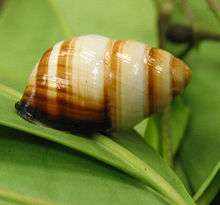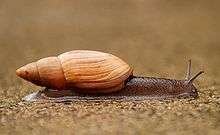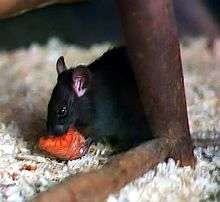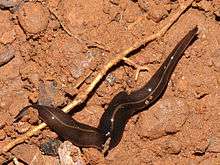Oʻahu tree snail
Oʻahu tree snails, genus Achatinella, form a large genus of colorful, tropical, tree-living, air-breathing, land snails, arboreal pulmonate gastropod mollusks in the family Achatinellidae.
| Oʻahu tree snail | |
|---|---|
 | |
| Achatinella bulimoides | |
| Scientific classification | |
| Kingdom: | |
| Phylum: | |
| Class: | |
| (unranked): | clade Heterobranchia clade Euthyneura clade Panpulmonata clade Eupulmonata clade Stylommatophora clade Orthurethra |
| Superfamily: | |
| Family: | |
| Subfamily: | Achatinellinae |
| Genus: | Achatinella Swainson, 1828 |
| Diversity | |
| 41 species,[1]
9 extant species remained in 2014[2] | |
This genus of tree snails is endemic to Hawaii, and all extant species are endangered. They were once abundant and were mentioned extensively in Hawaiian folklore and songs, and their shells were used in lei and other ornaments.
Many of these arboreal snails are sinistral or left-handed in their spiral shell coiling, whereas most gastropod shells are dextral. (See the section on chirality in the article gastropod shell.)
Distribution
There are 41 species[1] of Oʻahu tree snail endemic to Hawaiian island of Oʻahu. There are 13 surviving species. Some species have less than 50 remaining individuals, and others have +300; many species fall in between.
Conservation status
All 41 species are listed under United States federal legislation as endangered. The IUCN lists a number of these species as extinct and the remainder as critically endangered. The main cause of decline has been attributed to over collection. In addition, invasive species such as rats, Jackson's chameleons, and the highly predatory snail Euglandina rosea have been involved in the extinctions and declines of the native tree snails.[3]
Shell description
Oʻahu tree snails are diverse in patterns, colors, and shapes, but all average about 0.75 in (1.9 cm) in length. Most have smooth glossy, and oblong or ovate shells which show a variety of colors, including yellow, orange, red, brown, green, gray, black, and white.
There are three recognized subgenera within the genus Achatinella.[4] Subgenera are distinguished according to shells characteristics only.
Genus Achatinella Swainson, 1828: The dextral or sinistral shell is imperforate or minutely perforate, oblong, ovate or globose-conic; smooth or longitudinally corrugated, with only weak traces of spiral sculpture. Shell color is in spiral bands or streaks in the direction of the growth lines. The lip is simple or thickened within and sometimes slightly expanding. The columella bears a strong callous fold. Type species of the genus Achatinella is Achatinella apexfulva (Dixon).[4]
Subgenus Bulimella Pfeiffer, 1854: Shell shape is oblong-conic or ovate. The spire is obtuse, rounded or convexly-conic near the apex. The outer lip is thickened by a strong callous rib within the aperture (except in Achatinella abbreviata and Achatinella lila). Type species of the subgenus Bulimella is Achatinella byronii Newcomb.[4]
Subgenus Achatinellastrum Pfeiffer, 1854: The shell is imperforate, ovate-conic or oblong-conic and smooth. The embryonic whorls are not flattened. The outer lip is thin or only slightly thickened within the apex but not expanded. These are the most generally distributed of the Achatinella species and show a prolific area of intergrading color patterns. Type species of the subgenus Achatinellastrum is Achatinella stewartii (Green, 1827).[4]
Ecology
Habitat
These snails live in trees. Currently they are only found in mountainous dry to moist forests and shrublands above 1,300 ft (400 m). Most individuals spend their entire life on just one tree.
Feeding
These tree snails are nocturnal, and feed by grazing fungus which grows on the surface of native plant leaves.
Although these tree snails are occasionally found on introduced plants, it is unknown whether or not the fungus which grows on these plants can provide long-term support for healthy breeding populations of these snails.
In captivity Achatinella feed on fungus growing on leaves of Metrosideros polymorpha. They also feed on cornstarch, which can be spread in terraria with water and on cultures of sooty mold grown on laboratory agar. In captivity, cuttlebone is used as a source for calcium.[4]
Life cycle
Adult snails are hermaphroditic (having both male and female reproductive organs) and can live for many years. These are live bearing snails (give birth to live snails instead of laying eggs).
Predation and other threats
Because growth rate and fertility are very low, these snails are especially vulnerable to loss of individuals through human collection, through predation, or because of other disturbances.
The most serious threats to the survival of Oʻahu tree snails are predation by the introduced carnivorous snail Euglandina rosea, predation by rats (Rattus exulans, Rattus norvegicus, Rattus rattus),[1] and loss of habitat due to the spread of non-native vegetation into higher elevation forests.
Jackson's chameleon Trioceros jacksonii, that was introduced to Hawaii in early 1970s, is a serious threat to Achatinella, because it directly preys on them and on other snails too.[1][2] Other predators of Achatinella include the land planarian Platydemus manokwari.[1]
Predators of Achatinella:
Hawaiian folklore
%2C_Bailey_House_Museum.jpg)
According to Ancient Hawaiian folklore, the Kāhuli snails are known as the pūpū kani oe, which translates to "shell that sounds long" or the "singing shell". They are believed to be able vocalize and sing at night. Experts have attributed this association to the chirping of crickets at night when the snails are active. Native Hawaiians used the shells of the snails to create kahuli shell lei and their status as coveted souvenirs in the 19th-century may have contributed to the decline of the species. The summer palace of King Kamehameha III was called Kaniakapupu ("the singing of the land shells") because of the many snails which once inhabited the area during his lifetime.[5][6]
Species
There are 41 species in the genus Achatinella:[4]
Subgenus Achatinella
- †Achatinella apexfulva (Dixon, 1789)
- Achatinella cestus Newcomb, 1853
- Achatinella concavospira Pfeiffer, 1859
- †Achatinella decora (Férussac, 1821)
- Achatinella leucorraphe (Gulick, 1873)
- Achatinella lorata Férussac, 1824
- Achatinella mustelina Mighels, 1845
- Achatinella swiftii Newcomb, 1853
- Achatinella turgida Newcomb, 1853
- †Achatinella valida Pfeiffer, 1855
- Achatinella vittata Reeve, 1850
Subgenus Bulimella
- †Achatinella abbreviata Reeve, 1850
- Achatinella bulimoides Swainson, 1828
- Achatinella byronii (Wood, 1828)
- Achatinella decipiens Newcomb, 1854
- Achatinella fuscobasis (E. A. Smith, 1873)
- Achatinella lila Pilsbry, 1914
- Achatinella pulcherrima Swainson, 1828
- Achatinella pupukanioe Pilsbry & Cooke, 1914
- Achatinella sowerbyana Pfeiffer, 1855
- Achatinella taeniolata Pfeiffer, 1846
- Achatinella viridans Mighels, 1845
- †Achatinella elegans Newcomb, 1853
Subgenus Achatinellastrum
- Achatinella bellula E. A. Smith, 1873
- †Achatinella buddii Newcomb, 1853
- †Achatinella casta Newcomb, 1853
- †Achatinella caesia Gulick, 1858
- Achatinella curta Newcomb, 1853
- †Achatinella dimorpha Gulick, 1858
- Achatinella fulgens Newcomb, 1853
- †Achatinella juddii Baldwin, 1895
- †Achatinella juncea Gulick, 1856
- †Achatinella lehuiensis E. A. Smith, 1873
- †Achatinella livida Swainson, 1828
- †Achatinella papyracea Gulick, 1856
- Achatinella phaeozona Gulick, 1856
- †Achatinella spaldingi Pilsbry & Cooke, 1914
- Achatinella stewartii (Green, 1827)
- †Achatinella thaanumi Pilsbry & Cooke, 1914
- Achatinella vulpina (Férussac, 1824)
References
This article incorporates public domain text (a public domain work of the United States Government) from reference.[4] [7] [8] [9]
- Holland B. S., Montgomery S. L. & Costello V. (2010). "A reptilian smoking gun: first record of invasive Jackson’s chameleon (Chamaeleo jacksonii) predation on native Hawaiian species". Biodiversity and Conservation 19(5): 1437-1441. doi:10.1007/s10531-009-9773-5.
- Chiaverano L. M. & Holland B. S. (2014). "Impact of an invasive predatory lizard on the endangered Hawaiian tree snail Achatinella mustelina: a threat assessment". Endangered Species Research 24: 115-123, doi:10.3354/esr00589.
- Régnier, Benoît and Bouchet (2009). Not Knowing, Not Recording, Not Listing: Numerous Unnoticed Mollusk Extinctions. Conservation Biology 23(5): 1214–1221
- U.S. Fish and Wildlife Service. (1992) Endangered Species Recovery Plan for the O’ahu Tree Snails of the Genus Achatinella. U.S. Fish and Wildlife Service, Portland, Oregon, 64 pp. + 64 pp. of appendices + 5 figures. PDF Archived 2011-10-17 at the Wayback Machine
- Crowl, Janice (April–May 2011). "Kahuli Homecoming". Hana Hou!. 14 (2). Honolulu. Archived from the original on March 9, 2017. Retrieved March 7, 2017.
- "Kāhuli Tree Snails". National Wildlife Federation. Retrieved March 7, 2017.
- Holland, B.S. & M.G. Hadfield. 2007. Molecular systematics of the endangered O‘ahu tree snail Achatinella mustelina (Mighels 1845): Synonymization of subspecies and estimation of gene flow between chiral morphs. Pacific Science, 61(1): 53-66.
- Holland, B.S. & M.G. Hadfield. 2004. Origin and diversification of the endemic Hawaiian tree snails (Achatinellinae: Achatinellidae) based on molecular evidence. Molecular Phylogenetics and Evolution. 32(2): 588-600.
- Holland, B.S. & M.G. Hadfield. 2002. Islands within an island: phylogeography and conservation genetics of the endangered Hawaiian tree snail Achatinella mustelina. Molecular Ecology 11: 365-375.
Further reading
External links
| Wikispecies has information related to Achatinella |
| Wikimedia Commons has media related to Achatinella. |



